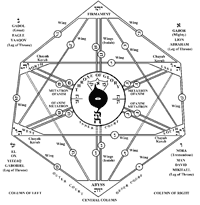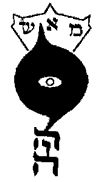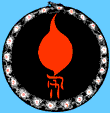




F. Ma'aseh Merkabah (Chariot) Literature

Among the principal works of the written Qabalah, significant material is
devoted to the description of the Celestial Chariot (Merkabah), or
"Throne of Glory of El Shadai."
The Chariot is generally an allusion to the Tree of Life, and especially
to the four Sefiroth in the central matrix of the three-dimensional Tree
of Perfection. These four are collectively referred to as the "Inner
Court" of the Tree. The Lord YHVH is variously said to be "riding
in the Chariot" and "seated upon the Throne" in the similitude
of a man (i.e. Adam Kadmon, the "Celestial Man"). In the Ketuvim
(Writings) of the Jewish scripture (called Tanakh),
this material is concentrated in the books of Ezekiel 1-3, 8, 10
(see Diagram) and Isaiah
6. Specific verses in these books yield a three-dimensional, six-pointed
form of the Tree similar to the one delineated by the Sefer Yetzirah,
but with distinct differences in the Inner Court and additional imagery
associated with four of the Directional Sefiroth.
The most prolific descriptions of the Merkabah appear in the Books of
Enoch. Enochian literature takes its name from Enoch son of Yared. Enoch
was "a righteous man in his generation" and "walked with
Elohim.Torah B’reshith 5:22." It is believed that in ancient times there may have
been as many as 100,000 volumes of Enochian literature, nearly all of whose
last remains were lost in the fiery destruction of the Great Library of
Alexandria. This literature was virtually unknown from the fourth (when
banned by Hilary, Jerome, and Augustus) until the late nineteenth century
CE, when three manuscripts deemed as authentic Enochian material were discovered.
Two of the manuscripts, I Enoch and III Enoch, were in Ethiopian
translation: these were found in what was once Abyssinia, the domain of
King Solomon's infamous lover, the Queen of Sheba. The third manuscript,
called II Enoch and the "Book of the Secrets of Enoch,"
was preserved in two Slavonic versions: these were found in Russia and Serbia.
I Enoch and II Enoch were translated by R.H. Charles. H. Odeburg
translated III Enoch ("Hebrew Book of Enoch")Work of the Chariot Trust. Books of Enoch, Los Angeles,
1972. Includes R.H. Charles translation of I Enoch and II
Enoch; H.Oldeburg’s translation and Hebrew text of III
Enoch; and an original translation of the Sh’ir Qoma.. The
Books of Enoch that are mentioned here should not be confused with
the "Canons of Enoch," which were discovered and translated
into European languages in the early nineteenth century. These latter books,
which influenced Romantic artists and poets such as Thomas Moore, William
Blake, and Lord Byron, are from a different tradition.
The authorship and dates of origin of the remaining Enochian books are obscure.
The three manuscripts cited, replete with errors of addition, corruption,
and omission, may well be the remnants of volumes given to Sheba by King
Solomon and subsequently handed down through generations. At the very least,
biblical scholars agree that the Books of Enoch are the most important
Apocrypha and Pseudoepigrapha pre-dating the Christian era. It has been
well established that all New Testament authors were more or less influenced by them.R.H. Charles discusses the influence of the Enochian
literature upon the New Testament authors in the
introduction to his translations of I Enoch and II Enoch. On
an additional note, it is very likely that the Urantia Book was
largely based on the Books of Enoch. The translations of the three Books of Enoch had been long
out of print by the time the Work of the Chariot Trust republished them
in the early 1970's.
The texts address a wide range of topics: there are numerous messianic references,
extensive angeologies and demonologies, elaborate descriptions of the various
heavens and hells, lists of Divine Names, lists of names of Metatron, and
allusions to mystical states associated with ascending the Tree. The most
prominent Merkabah sections describe the ascension and transformation of
Enoch ben Yared into Metatron, known as "The Youth"The Name Metatron is unusual for its two
consecutive central letter Tets. The ascension and
transformation of Enoch into Metatron is a primary topic in I
Enoch. Metatron is also frequently called the "Prince of the
Presence" and "The Youth." (Nar)
to whom the Lord YHVH revealed the deepest secrets, and whom the Lord YHVH
made the "operational manager" of this universe. Metatron, chief
of the angels, is referred to in the Tanakh (notably in Proverbs
22.6 and Job 32.6), as well as the Zohar (I.223b). III Enoch,
the "Hebrew Book of Enoch," contains a long discourse on
the ascension of the Celestial Chariot by Rabbi Ishmael, the last High Priest
before the destruction of the first Temple of Jerusalem. The ascension of
Rabbi Ishmael drew vigorous protests from some of the high angels, who objected
to the admission of his relatively impure human spirit to the supernal World
of Emanation (called Atziluth). When high angels get too close to the supernal
Sefiroth in the World of Atziluth, their wings burn. The ascension by Rabbi
Ishmael of the Celestial Chariot is a narrative allegory for the mystical
ascent of the Central Column of the Tree.
 Another obscure but important treatise included among Merkabah literature
is the Sefer Raziel HaGadol (Book of Raziel the Great)Raziel HaGadol, i.e. the archangel Raziel, is described as the
keeper of the secrets or mysteries. The earliest extant edition
of the Sefer Raziel is the Amsterdam manuscript dated 1701.,
which contains a subtext within it called the Sh'ir Qoma or
"Measure of the Divine Body." The Sh'ir Qoma presents
copious lists of Divine Names and, uniquely, a series of dimensions ascribed
to the "Divine Body" or Yosher (lit. upright) form of the
Name YHVH.
All current Hebrew texts of the Sh'ir Qoma come from a single
text, the corrupt edition published by Eleazer of Worms in Amsterdam in
1701 CE. The dimensions given in that text do not yield a reasonable image.
The Work of the Chariot Trust published the first, and until recently only,
English translation of the Sh'ir Qoma, and included it in
its edition of the Books of Enoch. The translator adjusted the dimensions
so that a reasonable Yosher is produced, and the overall size correlates
roughly to the currently accepted size of the sidereal universe.
Another obscure but important treatise included among Merkabah literature
is the Sefer Raziel HaGadol (Book of Raziel the Great)Raziel HaGadol, i.e. the archangel Raziel, is described as the
keeper of the secrets or mysteries. The earliest extant edition
of the Sefer Raziel is the Amsterdam manuscript dated 1701.,
which contains a subtext within it called the Sh'ir Qoma or
"Measure of the Divine Body." The Sh'ir Qoma presents
copious lists of Divine Names and, uniquely, a series of dimensions ascribed
to the "Divine Body" or Yosher (lit. upright) form of the
Name YHVH.
All current Hebrew texts of the Sh'ir Qoma come from a single
text, the corrupt edition published by Eleazer of Worms in Amsterdam in
1701 CE. The dimensions given in that text do not yield a reasonable image.
The Work of the Chariot Trust published the first, and until recently only,
English translation of the Sh'ir Qoma, and included it in
its edition of the Books of Enoch. The translator adjusted the dimensions
so that a reasonable Yosher is produced, and the overall size correlates
roughly to the currently accepted size of the sidereal universe.
 The "Sh'ir Qoma"
is the vision of the Creation as a unity in the Name YHVH. It is seen when
returning from the negatively existent roots of the Tree, looking down at
the Sefirah in the throat center from the Sefirah at the crown of the head.
The Yosher is a distinctly anthropomorphic form of the Name YHVH.
It is encircled by the Leviathan ("leh-vee-ah-than") of
Vast Face, described as a "snake devouring its tail."The Snake devouring its tail (i.e. with the end contained in
the beginning) is an allusion found in various forms
throughout the world’s mystical traditions. The form of such
a snake is O , the Sinatic Hebrew Ayin of Vast Face. The Leviathan
acts as a circular "fence" around the Yosher and defines
the field of superimposition. It also displays the ubiquitous mystical principle
that "the end is contained in the beginning." An obscure teaching
says that the Yosher drips out from Leviathan's fang. This is paralleled
in the Tantric tradition, where Shiva is described as swallowing
the "poison" of Maya (illusion) and holding it in his throat.
In the Sifra Detzniyutha 1, we find the verse:
The "Sh'ir Qoma"
is the vision of the Creation as a unity in the Name YHVH. It is seen when
returning from the negatively existent roots of the Tree, looking down at
the Sefirah in the throat center from the Sefirah at the crown of the head.
The Yosher is a distinctly anthropomorphic form of the Name YHVH.
It is encircled by the Leviathan ("leh-vee-ah-than") of
Vast Face, described as a "snake devouring its tail."The Snake devouring its tail (i.e. with the end contained in
the beginning) is an allusion found in various forms
throughout the world’s mystical traditions. The form of such
a snake is O , the Sinatic Hebrew Ayin of Vast Face. The Leviathan
acts as a circular "fence" around the Yosher and defines
the field of superimposition. It also displays the ubiquitous mystical principle
that "the end is contained in the beginning." An obscure teaching
says that the Yosher drips out from Leviathan's fang. This is paralleled
in the Tantric tradition, where Shiva is described as swallowing
the "poison" of Maya (illusion) and holding it in his throat.
In the Sifra Detzniyutha 1, we find the verse:
"The engraving of all engravings appears as a long serpent.
And extends this way and that. The tail is in the head.
The head goes around to the shoulders. Passing and indignant.
Guarding and concealing, revealing itself in a thousand short days."
-Sifra Detzniyutha 1